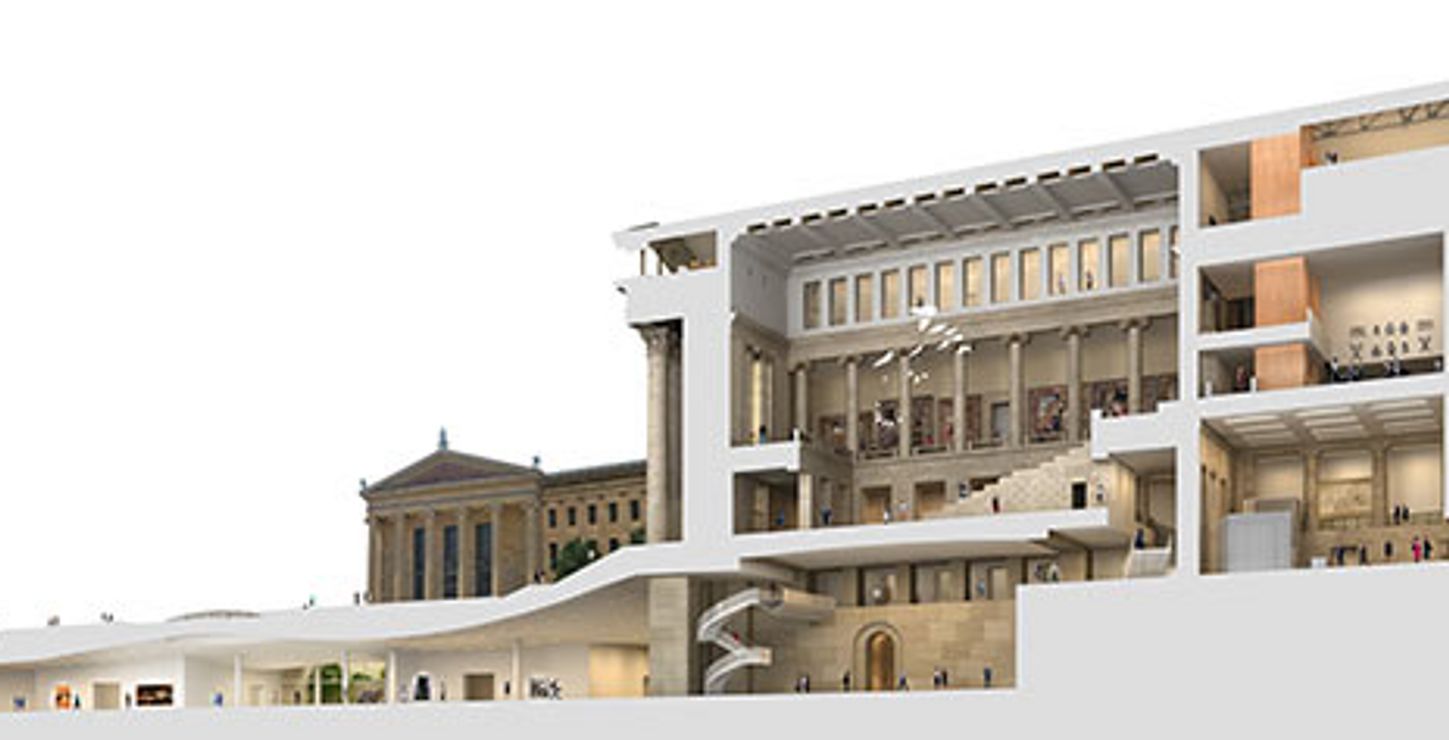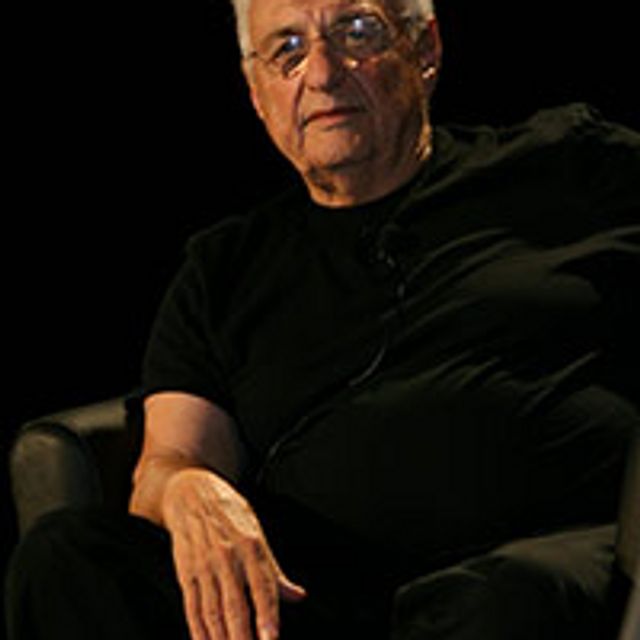Dorrance Special Exhibition Galleries, first floor
Main Building

A cross-section view showing the changes to the existing interior spaces and the new underground galleries. Rendering © Gehry
Partners, LLP
Presented for the first time in this exhibition is the comprehensive design for the renewal and expansion of the Philadelphia Museum of Art by internationally celebrated architect Frank Gehry. Best known for the expressive sculptural forms of buildings such as the Guggenheim Museum in Bilbao, Spain, Gehry's approach to this project is dramatically different and virtually unique. It focuses on the transformation of the interior of our main building through the renovation of beloved spaces like the Great Stair Hall, dramatic improvements to how our visitors will enter and move through the museum, and the creation of a substantial amount of new space for the display of more works of art and for a new Education Center.
Gehry's design is the embodiment of creative stewardship. It reflects a deep sympathy for a much beloved architectural landmark and, at the same time, an understanding of how this facility needs to be changed to continue to serve the needs of our visitors and our community. It is, in sum, an inspiring blueprint for the future of the Philadelphia Museum of Art and one in which we believe everyone should have an interest.
Learn more about this great building and how this project proposes both to conserve and improve it. Carefully detailed, large-scale models, architectural drawings, photographs, and videos are featured in the exhibition.
Dorrance Special Exhibition Galleries, first floor
Main Building
Raised in Toronto, Frank Gehry moved with his family to Los Angeles in 1947. He received a bachelor of architecture degree from the University of Southern California in 1954, and studied city planning at the Harvard University Graduate School of Design. In subsequent years, Gehry has built an architectural career that has spanned more than five decades and has produced public and private buildings in North America, Europe, and Asia. Hallmarks of Gehry's work include a particular concern that people exist comfortably within the spaces he creates, and an insistence that his buildings address the context and culture of their sites and the budgets of his clients.
Frank Gehry's work has earned him several of the most significant awards in the field of architecture. He was inducted into the College of Fellows of the American Institute of Architects (AIA) in 1974, and his buildings have received more than one hundred national and regional AIA awards. In 1977 Gehry was named recipient of the Arnold W. Brunner Memorial Prize in Architecture from the American Academy of Arts and Letters. In 1989 he was awarded the Pritzker Architecture Prize, perhaps the premier accolade of the field, which honors "significant contributions to humanity and the built environment through the art of architecture."
In 1992 Gehry received the Wolf Foundation Prize in Arts (Architecture) and was named the recipient of the Praemium Imperiale Award by the Japan Art Association to "honor outstanding contributions to the development, popularization, and progress of the arts." In 1994 he became the first recipient of the Dorothy and Lillian Gish Prize for lifetime contribution to the arts. In 1998 Gehry received the National Medal of Arts and became the first recipient of the Austrian Frederick Kiesler Prize for Architecture and the Arts. In 1999 he was honored with the Lotos Medal of Merit from the Lotos Club and the Gold Medal from the American Institute of Architects. In 2000 Gehry received the Royal Gold Medal from the Royal Institute of British Architects and a Lifetime Achievement Award from Americans for the Arts. In 2002 he received the Gold Medal for Architecture from the American Academy of Arts and Letters.
Frank Gehry was named a Fellow of the American Academy of Arts and Letters in 1987, a trustee of the American Academy in Rome in 1989, and a Fellow of the American Academy of Arts and Sciences in 1991. In 1994 he was bestowed with the title of Academician by the National Academy of Design. In 1998 he was named an Honorary Academician by the Royal Academy of Arts. In 2003 Gehry was inducted into the European Academy of Sciences and Arts and was designated as a Companion to the Order of Canada. In 2005 he received the Ordre National de Legion d'honneur Chevalier from the French government. In 2006 he was a first-year inductee into the California Hall of Fame. In 2008 he received the Golden Lion Lifetime Achievement Award at the Venice Biennale. In 2010 Gehry was given the John Singleton Copley Award from the American Associates of the Royal Academy Trust and the Cooper Union for the Advancement of Science and Art Award in New York.
Gehry has received honorary doctoral degrees from Occidental College, Whittier College, California College of the Arts, Technical University of Nova Scotia, Rhode Island School of Design, California Institute of Arts, Southern California Institute of Architecture, Otis Art Institute at the Parsons School of Design, University of Toronto, University of Southern California, Yale University, Harvard University, University of Edinburgh, Case Western Reserve University, and Princeton University. He has held teaching positions at some of the world's most prestigious institutions including Harvard University, University of Southern California, University of California, Los Angeles, Southern California Institute of Architecture (SCI-Arc), University of Toronto, Columbia University, Federal Institute of Technology in Zurich, and Yale University, where he still teaches today.
Notable architectural projects include the Guggenheim Museum, Bilbao, Spain; the Frederick R. Weisman Art Museum at the University of Minnesota; the Nationale-Nederlanden building, Prague; DZ Bank building, Berlin; the Richard B. Fisher Center for the Performing Arts at Bard College, Annandale-on-Hudson, New York; Maggie's Dundee, a cancer-patient center in Dundee, Scotland; Walt Disney Concert Hall, Los Angeles; Jay Pritzker Pavilion and BP Bridge in Millennium Park, Chicago; Hotel Marqués de Riscal, Elciego, Spain; Transformation Art Gallery of Ontario, Toronto; Peter B. Lewis Science Library, Princeton, New Jersey; Cleveland Clinic Lou Ruvo Brain Institute, Las Vegas; Ohr-O'Keefe Museum, Biloxi, Mississippi; New World Center, Campus of the New World Symphony, Miami Beach; 8 Spruce Street residential tower, New York City; Opus Hong Kong residential tower; Signature Theatre, New York City; and a house for the Make It Right foundation, New Orleans.
Current Gehry projects include the Guggenheim Abu Dhabi; LUMA Foundation, Arles, France; West-Eastern Divan Orchestra, Berlin; Dwight D. Eisenhower Memorial, Washington, DC; King Street development, Toronto; Philadelphia Museum of Art; Q-MOCA, Quanzhou, China; and the west campus for Facebook, Menlo Park, California. Projects under construction are Puente de Vida Museum of Biodiversity, Panama; Fondation Louis Vuitton, Paris; and the Dr. Chau Chak Wing Building for the University of Technology, Sydney.

Timothy Rub, The George D. Widener Director and Chief Executive Officer